Today’s workbench welcomed a distinctive instrument: a Gene Simmons Punisher bass guitar. Rumor has it that only 1500 of these basses exist, each personally autographed and numbered by the legendary Gene Simmons himself. Exclusively sold through Hot Topic, these basses have become somewhat of a collector’s item, appealing to fans and musicians alike.
This particular Gene Simmons Bass Guitar, however, had seen considerable action. Its owner, clearly an enthusiastic player, had put the instrument through its paces. The result was uneven action across the fretboard, notes buzzing out, and some electronic issues that needed addressing. Upon inspection, a fret level was recommended as a crucial step to restore its playability, and with the client’s approval, the fretwork commenced.
The Critical Role of Fretwork in Bass Guitar Performance
Before diving into the specifics of this Gene Simmons bass guitar, it’s vital to understand why fretwork is paramount to any stringed instrument, especially bass guitars. Essentially, a bass guitar is only as good as its fretwork. If the frets aren’t perfectly level along the entire neck, the instrument simply cannot perform at its peak. To achieve clean and buzz-free playing, frets need to be level within an incredibly tight tolerance, approximately 0.01mm. This level of precision isn’t achievable by guesswork; accurate measurements and meticulous work are essential.
For consistent and precise fretwork, I utilize a custom-built neck jig. While we now leverage the precision of a PLEK machine for our fretwork (more details here), the neck jig remains a valuable tool and demonstrates the principles of maintaining proper neck geometry during fretwork. This jig allows me to work on the neck under simulated playing conditions, ensuring accuracy. Here’s a breakdown of the process used on this Gene Simmons Punisher bass:
First, after initial assessments, the strings were removed. The fretboard was then waxed, and a thin layer of super glue was carefully wicked under each fret. This crucial step stabilizes the frets, preventing movement during the leveling process and ensuring they remain seated in the future.
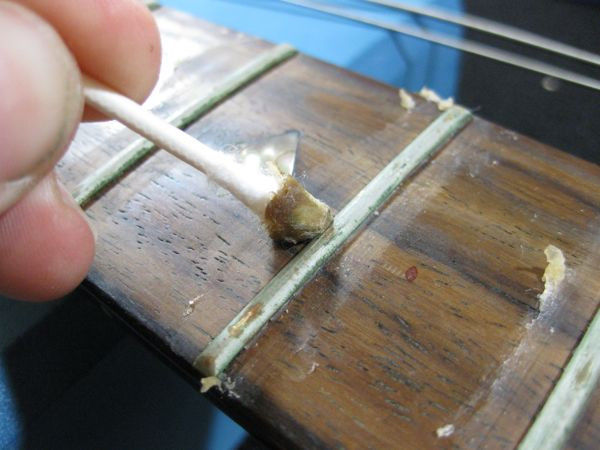 Close-up of the Gene Simmons Punisher bass fretboard during preparation for fretwork.
Close-up of the Gene Simmons Punisher bass fretboard during preparation for fretwork.
With the frets secured, the bass guitar was restrung to concert pitch. It was then carefully mounted into the neck jig, oriented in a playing position. Using the truss rod, the neck was meticulously adjusted to achieve maximum straightness. A Starret straightedge was used to verify the neck’s straightness, and dial indicators, positioned at six points along the neck, were zeroed out to establish a precise baseline measurement of the neck’s curvature under string tension.
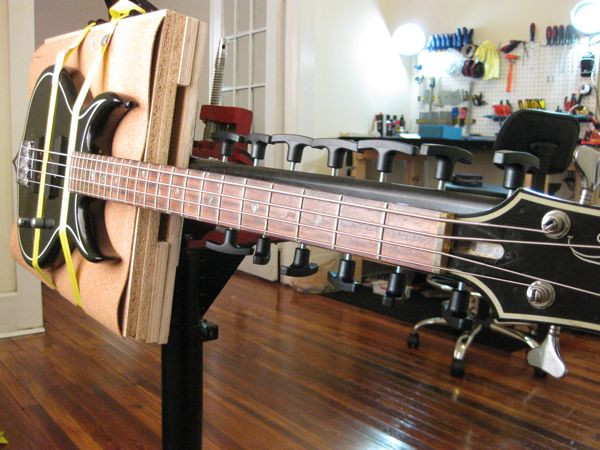 Gene Simmons Punisher bass secured in the neck jig, ready for precise measurement and fretwork.
Gene Simmons Punisher bass secured in the neck jig, ready for precise measurement and fretwork.
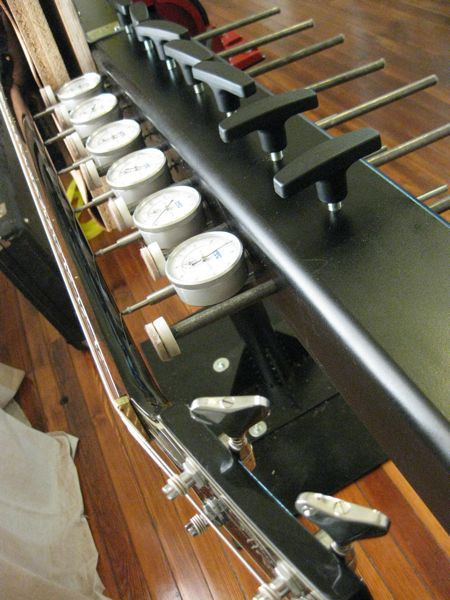 Dial indicators showing precise measurements of the Gene Simmons Punisher bass neck curvature in the jig.
Dial indicators showing precise measurements of the Gene Simmons Punisher bass neck curvature in the jig.
Next, the bass was flipped back to a working position, and the strings were removed once more. Employing a scissor jack and neck supports in conjunction with the dial indicators, the neck was carefully repositioned to precisely replicate the shape it held under playing tension. This step is critical because guitar necks can subtly shift when string tension is removed. The neck jig effectively eliminates these variables, ensuring that the fretwork is performed on a neck that mirrors its playing condition.
With the neck stabilized in its optimal shape, a full-length leveling beam fitted with abrasive material was used. This beam was gently and methodically swept across the frets. The leveling process carefully removes material from the tops of the frets, bringing them down to a uniform height.
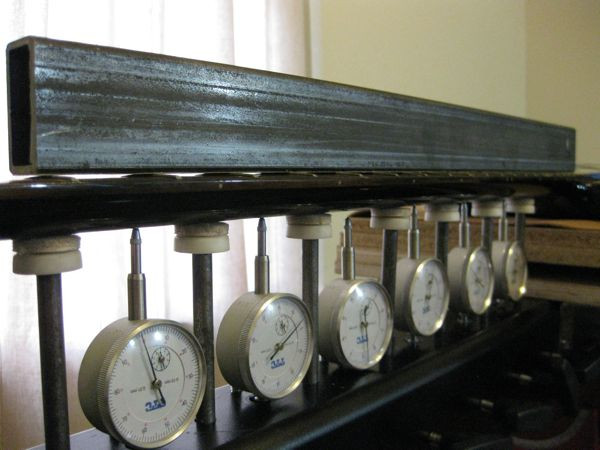 Fret leveling process on the Gene Simmons Punisher bass using a leveling beam.
Fret leveling process on the Gene Simmons Punisher bass using a leveling beam.
The image above clearly illustrates how the leveling beam made consistent contact with two adjacent frets, yet a section of the middle fret remained untouched. This highlighted a problem area that was indeed causing significant buzzing – the middle fret was lower than its neighbors, leading to string buzz against the subsequent fret.
Once the leveling beam had made contact across all fret tops, the next stage was recrowning. Leveling flattens the tops of the frets, so recrowning restores their proper rounded profile. A diamond-coated fret file was used for this task, making the process appear straightforward. However, careful and controlled strokes are essential to recrown the frets evenly without compromising the accuracy achieved during the leveling stage.
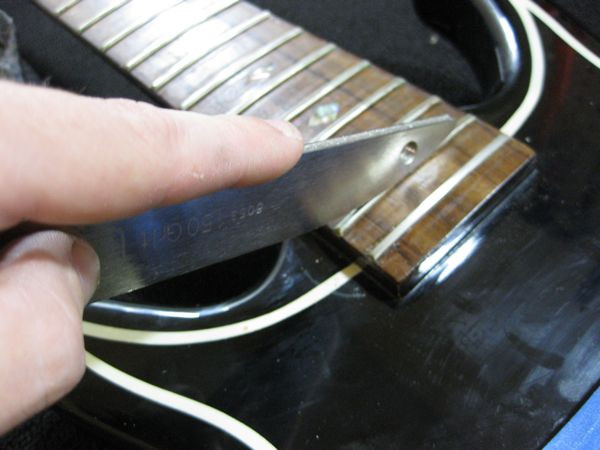 Recrowning the frets of the Gene Simmons Punisher bass using a diamond-coated fret file.
Recrowning the frets of the Gene Simmons Punisher bass using a diamond-coated fret file.
Following recrowning, the frets were meticulously polished. This involved progressing through increasingly finer grits of sandpaper, followed by steel wool, and culminating in buffing with a polishing wheel. Polishing not only enhances the aesthetic appeal of the frets, giving them a smooth, mirror-like shine, but also significantly improves playability. Polished frets facilitate smoother string bending and reduce friction.
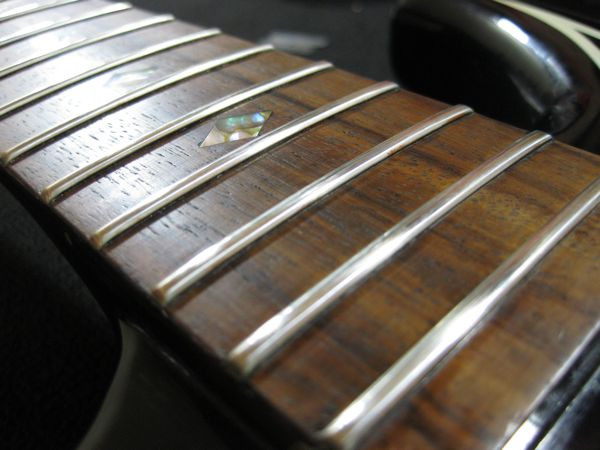 Polishing the frets of the Gene Simmons Punisher bass to a high shine for optimal playability.
Polishing the frets of the Gene Simmons Punisher bass to a high shine for optimal playability.
The Transformation: Playability Perfected
With the fretwork meticulously completed, the Gene Simmons bass guitar was ready for a no-compromise setup. Perfectly level frets unlock the potential for incredibly low action. Each note now rings out clearly, and string bends are executed without any unwanted fret buzz. Even if you believe your bass guitar plays well, it’s highly likely that it could benefit from some degree of professional fretwork. It’s an investment that can reveal a level of playability you might not have known was achievable.
The transformation in this Gene Simmons Punisher bass guitar was remarkable. The playability was significantly enhanced. It’s a testament to the impact of precise fretwork. This bass was now truly ready to rock.
